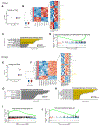Thymic stromal lymphopoietin induces IL-4/IL-13 from T cells to promote sebum secretion and adipose loss
- PMID: 38157943
- PMCID: PMC11211244
- DOI: 10.1016/j.jaci.2023.11.923
Thymic stromal lymphopoietin induces IL-4/IL-13 from T cells to promote sebum secretion and adipose loss
Abstract
Background: The cytokine TSLP promotes type 2 immune responses and can induce adipose loss by stimulating lipid loss from the skin through sebum secretion by sebaceous glands, which enhances the skin barrier. However, the mechanism by which TSLP upregulates sebaceous gland function is unknown.
Objectives: This study investigated the mechanism by which TSLP stimulates sebum secretion and adipose loss.
Methods: RNA-sequencing analysis was performed on sebaceous glands isolated by laser capture microdissection and single-cell RNA-sequencing analysis was performed on sorted skin T cells. Sebocyte function was analyzed by histological analysis and sebum secretion in vivo and by measuring lipogenesis and proliferation in vitro.
Results: This study found that TSLP sequentially stimulated the expression of lipogenesis genes followed by cell death genes in sebaceous glands to induce holocrine secretion of sebum. TSLP did not affect sebaceous gland activity directly. Rather, single-cell RNA-sequencing revealed that TSLP recruited distinct T-cell clusters that produce IL-4 and IL-13, which were necessary for TSLP-induced adipose loss and sebum secretion. Moreover, IL-13 was sufficient to cause sebum secretion and adipose loss in vivo and to induce lipogenesis and proliferation of a human sebocyte cell line in vitro.
Conclusions: This study proposes that TSLP stimulates T cells to deliver IL-4 and IL-13 to sebaceous glands, which enhances sebaceous gland function, turnover, and subsequent adipose loss.
Keywords: IL-13; IL-4; Sebaceous gland; T cells; TSLP; adipose loss; sebum.
Copyright © 2023 American Academy of Allergy, Asthma & Immunology. Published by Elsevier Inc. All rights reserved.
Conflict of interest statement
Conflict of Interest
U.S. Provisional Patent Application No. 62/972,462 was filed by the University of Pennsylvania. The inventors are Taku Kambayashi and Ruth Choa. The patent application is based on the finding that TSLP induces sebum secretion from the skin and that this can lead to treatment of skin conditions and obesity and its complications.
Figures





References
-
- Eyerich S, Eyerich K, Traidl-Hoffmann C, Biedermann T. Cutaneous Barriers and Skin Immunity: Differentiating A Connected Network. Trends Immunol. 2018;39(4):315–27. - PubMed
-
- Picardo M, Mastrofrancesco A, Bíró T. Sebaceous gland-a major player in skin homoeostasis. Exp Dermatol. 2015;24(7):485–6. - PubMed
MeSH terms
Substances
Grants and funding
LinkOut - more resources
Full Text Sources

